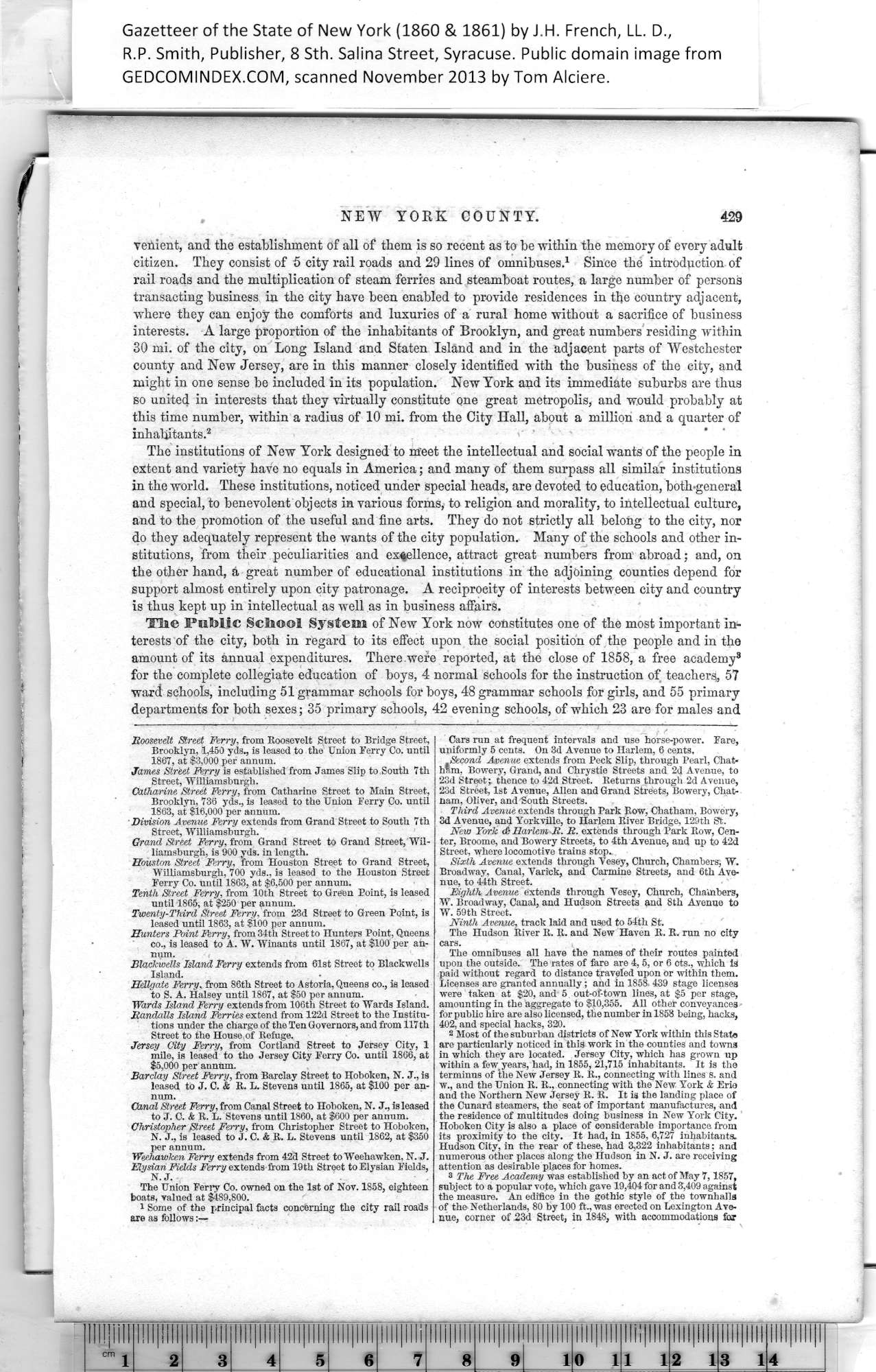|
Roosevelt Street Ferry, from Roosevelt Street to Bridge Street,
Brooklyn, 1,450 yds., is leased to tlie Union Ferry Co. until
1867, at $3,000 per annum.
James Street Ferry is established from James Slip to South 7th
Street, Williamsburgh.
Catharine Street Ferry, from Catharine Street to Main Street,
Brooklyn, 736 yds., is leased to the Union Ferry Co. until
1863, at $16,000 per annum.
Division Avenue Ferry extends from Grand Street to South 7th
Street, Williamsburgh.
Grand Street Ferry, from Grand Street to Grand Street, 'Wil¬
liamsburgh, is 900 yds. in length.
Houston Street Ferry, from Houston Street to Grand Street,
Williamsburgh, 700 yds., is leased to the Houston Street
Ferry Co. until 1863, at $6,500 per annum.
Tenth Street Ferry, from 10th Street to Green Point, is leased
until 1865, at $250 per annum.
Twenty-Third Street Ferry, from 23d Street to Green Point, is
leased until 1863, at $100 per annum.
Hunters Paint Ferry, from 34th Street to Hunters Point, Queens
Co., is leased to A. W. Winants until 1867, at $100 per an¬
num.
Blackwells Island Ferry extends from 61st Street to Blackwells
Island.
Hdlgate Ferry, from 86th Street to Astoria, Queens co., is leased
to S. A. Halsey until 1867, at $50 per annum.
Wards Island Ferry extends from 106th Street to Wards Island.
Randalls Island Ferries extend from 122d Street to the Institu¬
tions under the charge of the Ten Governors, and from 117th
Street to the House of Refuge.
Jersey City Ferry, from Cortland Street to Jersey City, 1
mile, is leased to the Jersey City Ferry Co. until 1866, at
$5,000 per annum.
Barclay Street Ferry, from Barclay Street to Hoboken, N. J., is
leased to J. C. & R. L. Stevens until 1865, at $100 per an¬
num.
Canal Street Ferry, from Canal Street to Hoboken, N. J., is leased
to J. C. & R. L. Stevens until 1860, at $600 per annum.
Christopher Street Ferry, from Christopher Street to Hoboken,
N. J., is leased to J. C. & R. B. Stevens until 1862, at $350
pier annum.
Weehawken Ferry extends from 42d Street to Weehawken, N. J.
Elysian Fields Ferry extends from 19th Street toElysian Fields,
N. J.
The Union Ferry Co. owned on the 1st of Nov. 1858, eighteen
boats, valued at $489,800.
i Some of the principal facts concerning the city rail roads
are as follows |
Cars run at frequent intervals and use horse-power. Fare,
uniformly 5 cents. On 3d Avenue to Harlem, 6 cents,
Second Avenue extends from Peck Slip, through Pearl, Chat¬
ham, Bowery, Grand, and Chrystie Streets and 2d Avenue, to
23d Street;, thence to 42d Street. Returns through 2d Avenue,
2-3d Street, 1st Avenue, Allen and Grand Streets, Bowery, Chat-
nam, Oliver, and South Streets.
Third Avenue extends through Park Row, Chatham, Bowery,
3d Avenue, and Yorkville, to Harlem River Bridge, 129th St.
New Fork <& Harlem R. R. extends through Park Row, Cen¬
ter, Broome, and Bowery Streets, to 4th Avenue, aud up to 42d
Street, where locomotive trains stop.
Sixth Avenue extends through Vesey, Church, Chambers, W.
Broadway, Canal, Varick, and Carmine Streets, and 6th Ave¬
nue, to 44th Street.
Eighth Avenue extends through Vesey, Church, Chambers,
W. Broadway, Canal, and Hudson Streets and 8th Avenue to
W. 59th Street.
Ninth Avenue, track laid and used to 54th St.
The Hudson River R. R. and New Haven R. R. run no city
cars.
The omnibuses all have the names of their routes painted
upon the outside. The rates of fare are 4,5, or 6 cts., which is
paid without regard to distance traveled upon or within them.
Licenses are granted annually; and in 1858 439 stage licenses
were taken at $20, and 5 out-of-town lines, at $5 per stage,
amounting in the aggregate to $10,355. All other conveyances
for public hire are also licensed, the number in 1868 being, hacks,
402, and special hacks, 320.
8 Most of the suburban districts of New York within this State
are particularly noticed in this work in the counties and towns
in which they are located. Jersey City, which has grown up
within a few years, had, in 1855, 21,715 inhabitants. It is the
terminus of the New Jersey R. R., connecting with lines s. and
w., and the Union R. R., connecting with the New York & Erie
and the Northern New Jersey R. R. It is the landing place of
the Cunard steamers, the seat of important manufactures, and
the residence of multitudes doing business in New York City.
Hoboken City is also a place of considerable importance from
its proximity to the city. It had, in 1855, 6,727 inhabitants.
Hudson City, in the rear of these, had 3,322 inhabitants; and
numerous other places along the Hudson in N. J. are receiving
attention as desirable places for homes.
3 The Free Academy was established by an act of May 7, 1857,
subject to a popular vote, which gave 19,404 for and 3,409 against
the measure. An edifice in the gothic style of the townhalls
of the Netherlands, 80 by 100 ft., was erected on Lexington Ave¬
nue, corner of 23d Street, in 1848, with accommodations for |
